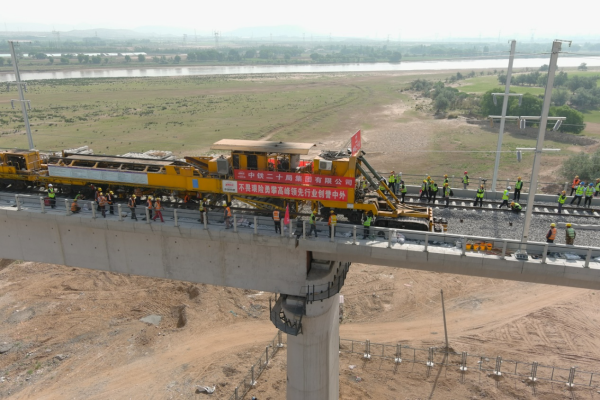The final 500-meter-long rails were meticulously positioned at the Wuhai Yellow River Grand Bridge construction site along the Baotou-Yinchuan High-Speed Railway, symbolizing the successful conclusion of track-laying efforts in the Inner Mongolia segment.
This milestone, achieved with the participation of China Railway 20th Bureau Group Corporation Limited, a subsidiary of China Railway Construction Corporation Limited, lays a solid foundation for the railway’s scheduled opening within the year.

Track-laying site at the Wuhai Yellow River Grand Bridge on the Baotou-Yinchuan High-Speed Railway [Photo/sasac.gov.cn]
The Baotou-Yinchuan High-Speed Railway is a key component of the Beijing–Lanzhou corridor in China’s “Eight Vertical and Eight Horizontal” high-speed railway network. Spanning 519 kilometers from Baotou in Inner Mongolia to Yinchuan in Ningxia, the line passes through Bayannur, Ordos, Wuhai, and Shizuishan. It serves as a vital artery connecting northwestern China with the northeast and north China regions. The Inner Mongolia section extends 402 kilometers and is designed for speeds of up to 250 km/h.
Track-laying for the Inner Mongolia section began in August 2024. The project involved 800 kilometers of mainline track and the placement of 2.2 million cubic meters of ballast. Two main track-laying bases were established at Xixiaozhao and Jiangui. The project faced challenges such as a tight construction schedule, demanding precision standards, and elevated safety risks during winter operations. At its peak, the project deployed over 200 sets of large-scale machinery and mobilized more than 2,700 workers to ensure both progress and quality.
The use of domestically developed BLCP500 and CPG500 track-laying machines significantly enhanced the level of automation and precision in sleeper placement, boosting the overall efficiency and quality of the track-laying process.
Once fully operational, the railway will cut travel time between Baotou and Yinchuan from over six hours to just two. As the fastest route from western Inner Mongolia and Ningxia to Beijing, the railway will play a pivotal role in improving China’s high-speed rail network layout, optimizing the Beijing–Lanzhou corridor’s transport capacity, meeting growing demand for efficient travel, and driving coordinated development along the Yellow River urban cluster. It is also expected to provide strong momentum for the broader economic and social advancement of northwestern China.
(Executive editor: Cui Feng)